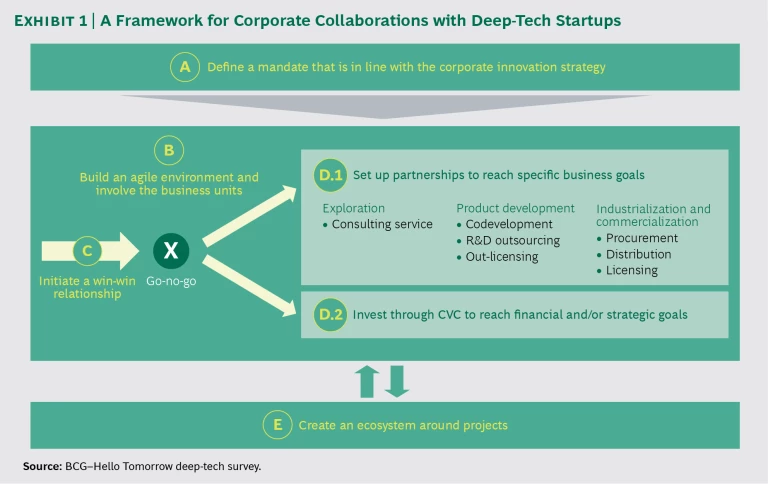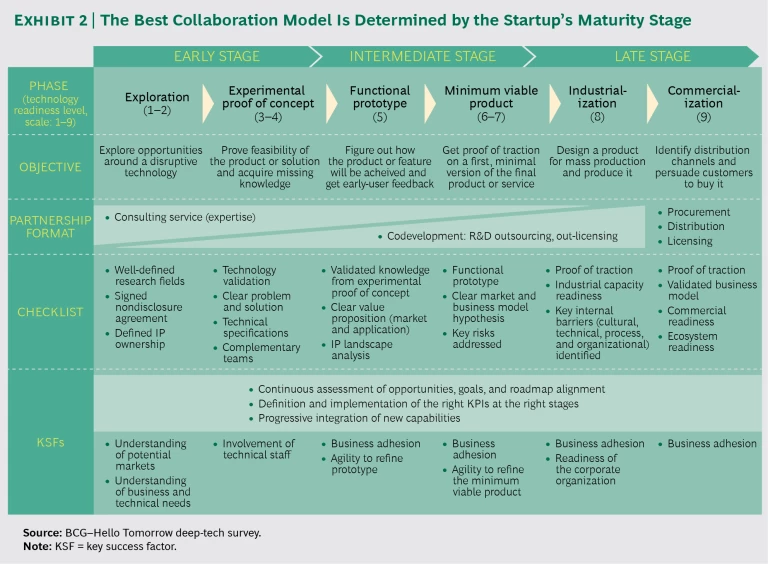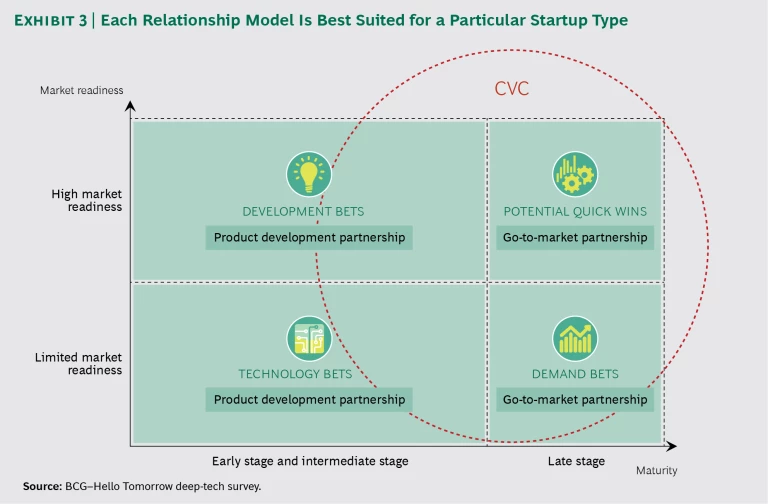This article is the second in a two-part series on how big companies can collaborate with entrepreneurs and startups engaged in “deep technology”—developing technologies that advance scientific and technological frontiers in industries as diverse as agriculture, health care, energy, and transportation. These are technologies that in many cases address the biggest societal and environmental challenges and shape the way we solve the most pressing global issues. The first, “ What Deep-Tech Startups Want from Corporate Partners ,” BCG article, April 2017, considers young companies’ needs with respect to other players in the startup ecosystem, particularly large corporations. This article looks at ways companies can go about setting up collaborations with deep-tech startups. Both articles are based on research conducted by BCG and Hello Tomorrow, a global initiative that connects deep-tech entrepreneurs with corporations and investors. The research involved more than 400 deep-tech startups. BCG and Hello Tomorrow also conducted in-depth interviews with other key ecosystem players, including investors, support organizations, and mentors. The full results are presented in the report From Tech to Deep Tech: Fostering Collaboration Between Corporates and Startups .
Collaborations between big companies and startups are the business world’s odd couples—two entities, which at an operational level have little in common, trying to work together. A recent study reported that “50% of startups said that their experience working with corporations was mediocre or worse.” At the same time, according to that study, 82% of corporations view interactions with startups as “somewhat important” to “very important.” Almost a quarter said that
Define the Mandate
Successful companies develop innovation models and systems that are suited to their circumstances and reflect their corporate strategies. (See The Most Innovative Companies 2016: Getting Past “Not Invented Here,” BCG report, January 2017.) Successful companies also define a mandate for their innovation programs, ensuring that their organizations know what the goals, focus, and parameters of these efforts are. The mandate need not be long or complicated, but it should cover the following points:
- The Company’s Innovation Objectives. These may focus on strengthening the core business, expanding into adjacent areas, or exploring and preparing for future entry into currently unrelated business areas. The role of deep tech—compared with the application of digital technologies to existing products, services, processes, and functions—should be highlighted.
- R&D Focus. The topics on which the company wants to focus its R&D efforts should be defined.
- Preferred Partner Profile. An approximate profile of the kind of startups the company wants to partner with should include, for example, whether they are in early-stage, intermediate-stage, or late-stage development.
- Resources. A description of the required resources should specify, for example, the budget, people, and facilities that will be needed to meet the mandate.
Companies also need to define the desired balance between internal sourcing of innovation, using the company’s own capabilities, and external sourcing of innovation, including partnering with deep-tech startups.
Construct a Startup-Friendly Environment
Lots of large companies have established CVC arms, incubators and accelerators, and innovation labs to house their external innovation programs. These models can work well, especially when the sponsoring companies are leveraging the scale effect of working with a significant number of startups with similar development cycles and needs. Because so many deep-tech startups have unique technologies and singular development cycles, however, they don’t necessarily fit comfortably into such systems. Moreover, relying on a standalone operation can mask the parent company’s organizational and cultural barriers that should be addressed if it is to collaborate productively with younger, faster, more nimble partners. Companies have to think through, for example, how they plan to interact with startups, where decision power resides, whether they can act and react as promptly as startups expect and require, and what types of KPIs will be applied to assess progress.
On the basis of our research and case experience, we have identified five areas in which most corporate sponsors should assess their readiness for deep-tech collaboration.
Assuring That Processes Are Fast and Light. Big companies should either tailor their internal processes for more agile interaction or create parallel processes with dedicated staff to work with the smaller and more nimble startups while the rest of the organization focuses on business as usual. It is most important to adapt the processes, such as procurement, legal, and finance, on which the startups will lean regularly for support.
Making Certain That Governance Procedures Ensure Clear Responsibilities and Accountabilities. To ensure alignment with corporate goals and full management buy-in, companies need to set up a governance framework for startups that is anchored at top management levels and provides appropriate oversight.
Providing Startups with Easy Access to Resources. Startups look to corporate partners for nonfinancial assistance in several areas, the most important—from a startup’s point of view—being technical and business expertise and market access. From the sponsoring company’s perspective, getting value from its deep-tech ventures depends in part on engaging the relevant people and parts of the business. The company needs to identify the capabilities that potentially provide value—for example, data and access to customers, networks, mentors, and technical experts—and allow startups to navigate as freely as possible among them. Creating a network of engaged experts and champions across the business to act as project managers for the collaboration can help. Immersion programs enable talent from the company to work for the startups for predetermined periods. In addition to providing startups with access to expertise, such programs help companies enrich the development of their up-and-coming executive talent and emphasize entrepreneurial values in their own corporate cultures.
Adapting Company KPIs to Track Long-Term Results with a Portfolio Approach. The most consistently successful innovators have strong processes for reviewing development projects to ensure timely completion. But for collaborations with startups, they need to adapt these processes, especially those employed in areas not closely related to the core business. For nascent deep-tech ventures, for example, KPIs focused on short-term P&L impact can be counterproductive. KPIs should be adapted—by, for example, measuring knowledge acquisition in the early technology stages and financial impact in the later maturity stages—to reflect the maturity of the particular startup and the nature of the collaboration. KPIs should be clearly established from the beginning of the relationship and progress communicated regularly with the startup and within the company.
Making Sure That the Company Has the Right Culture and Mindset. Adapting the “hard” side of the organization—governance, processes, and KPIs—is not enough. Big-company and small-company values, cultures, and goals are different. The corporate individuals assigned to work with startups may need their own immersion in entrepreneurial cultures so that they can better understand what startups are trying to do and the particular challenges that they face. In this way, the corporate representatives will be able to see the startups as valuable partners to be championed throughout the larger organization.
Look Before You Leap
Deep-tech ventures represent deep commitment on both sides. Both corporate partners and startups are well advised to spend time “dating,” getting to know each other and their aspirations and expectations before entering into a more formal, longer-term relationship. One of the main challenges reported by both startups and large companies is the lack of transparency and alignment on common goals from the beginning. This is a problem that leads to wasted time and, perhaps, painful renegotiation down the road.
We have seen both sides benefit from temporary associations with clear (ad hoc) milestones for assessing how and when decisions could be made to extend and deepen the relationship. Companies and startups use these times to explore mutual goals, collaboration platforms, and team chemistry. They can also iron out potentially thorny issues—such as intellectual property (IP) rights—and test the viability of the partnership, achieving some quick wins, working on mutually defined projects, and building momentum through a short but intense period. They can agree on a common roadmap with clear milestones, defining the most efficient path to the common goal, with each milestone constituting an opportunity to assess the relationship, confirm or change the next milestone and go to the next level, or stop the relationship.
Choose the Right Model
Companies can choose from several different models—CVC arms, incubators and accelerators, and business partnerships—to bring relationships to the next level when it suits their deep-tech venturing objectives. As we indicated in the first article in this series, in many cases, the best model is determined by the startup’s maturity stage and its readiness to go to market. (See Exhibit 2.)
Partnership Models. Companies can pursue multiple models of partnership, each with its own advantages. For example, for startups in the early stages of development, a consulting-service arrangement allows the company to help pay for R&D as it takes the opportunity to review and assess the technology before it pursues a deeper and more complex relationship. When the startup has a more mature technology or product, the companies can pursue a product codevelopment deal under which they join forces with a dedicated budget, firm goals, and a clear time frame for going to market. Alternatively, they can engage in an R&D outsourcing arrangement, in which, for example, the startup develops a product for the sponsoring company.
At the most mature stage, when the product is market ready, there are several likely variations of commercial partnerships to follow. Such arrangements enable the startup to scale up and build the credibility it needs to persuade other companies to work with it. Distribution partnerships can help the startup accelerate revenue growth by tapping into the larger company’s marketing capabilities and customer base. Under a licensing agreement, the larger company can license the startup’s IP for its own use and sale to others.
The deals that each company and startup actually strike vary according to need and circumstance, but companies should start by defining a framework, including key success factors, for each startup maturity stage and a checklist to help validate its go-no-go decision at each stage gate. To avoid problems related to ambiguity, the companies must discuss exclusivity, a common roadblock, as early as possible in their relationship.
Exhibit 3 illustrates a framework, which organizations should fine-tune, depending on their objectives and capabilities, and use as a tool—rather than a standardized process—to facilitate decision making.
CVC Models. Companies generally use one of two CVC models: investments made through their own venture capital arms or investments made externally through an in-dependent venture fund. In both cases, the financial returns are an important factor, but the strategic benefits of the two differ.
The internal CVC model can be a powerful vehicle for aligning the interests and strategies of the startup and the sponsoring company, and it provides for a much closer collaboration on technology development, business planning, and going to market. It may limit the startup’s ability to work simultaneously with other companies that could benefit its technological development, however.
The external model does not require the sponsoring company to develop its own in-house capabilities and is most relevant when a company would like to explore opportunities in new areas. It provides access to the contacts of experienced venture capital funds and access to a range of investments that is broader than a company-owned CVC arm would likely see.
Whatever their CVC approach, companies need to have clear goals and know how they want deep tech to fit with their larger corporate strategy. They should ask themselves the following questions:
- What are our CVC-related objectives? In general, strategically oriented and financially oriented CVC investments have different goals. In 2016, BCG examined 83 CVC units and found that 66% were strategy focused, although positive ROI was also a prerequisite, and 34% focused purely on the financial returns of the investments they made. (See Corporate Venturing Shifts Gears .)
- Where—at the corporate center or in the business units—is the responsibility for defining the company’s deep-tech priorities and areas of focus? Definition at the corporate level will focus investments in innovations that could create new businesses or disrupt core businesses. Business unit responsibility is appropriate when the objective is to reinforce current business lines or develop adjacencies.
- Where should the CVC unit’s organizational home be? CVC units can be based in several functions of the organization, but strategy and R&D are the most common. The chosen department should possess relevant technology skills and market know-how in the business areas of focus and should be able to ensure close cooperation with the business units and key corporate functions.
- How many deals do we want to source? Companies can use CVC to gain exposure to a few high-potential or strategically important startups, or they can invest, and scout for opportunities, more broadly. The primary lessons companies should take from the venture capital industry are that attractive opportunities are few and the size of an investment is an important lever for managing investment risk and deepening knowledge of a technology ecosystem. BCG’s analysis of CVCs showed that only 0.5% of all business plans received made it to the investment stage. That is, companies screened some 700 business plans to make three or four CVC investments.
Build Your Own Ecosystem
Whatever form they take, the relationships between established companies and startups should not be built on the typical one-to-one basis. Instead, they should take into account cooperation and collaboration with the broader deep-tech ecosystem.
As we said in our first article , deep-tech entrepreneurs look to a broad ecosystem of organizations, institutions, and individuals for support and assistance. Corporations are preferred partners for a number of reasons, but startups do still look to others—including other startups, companies that are not direct competitors, suppliers, customers, and scientists—for support and assistance.
Building or tapping into a connected ecosystem has advantages for sponsoring companies as well. These include balancing the risks in a portfolio that includes many startups, enabling startups to help and mentor each other, and gaining a broader understanding of the scope of technologies under development. In addition, participating in the wider ecosystem of activity can help position a sponsoring company as an active participant in an emerging technology and gives it access to other participants when it comes time to address consensus-building issues such as industry standards.
An Initial Checklist for Building a Collaboration Platform
Partnering with deep-tech startups means making a serious commitment: success is far from guaranteed and payback time frames can be long. Before they make the commitment, companies should be sure that they have addressed some basic concerns.
Capabilities. Does the company have the internal capabilities and market experience to support the collaboration platform, or should it seek external assistance? Developing a company’s own deep-tech management structure requires know-how and reputation. It also requires market experience. Many companies that lack these capabilities prefer to partner with existing incubators or accelerators or to enter into simple mentorship arrangements. When defining their goals, companies must take into account their internal capabilities and cultural mindsets and define their ambitions accordingly.
Oversight. Which corporate function should oversee collaboration with startups? The answer depends in part on the technology readiness level (TRL) of the startup’s solution and the solution’s proximity to the sponsoring company’s business. Collaborations with startups that have a low TRL and technologies that are far from the company’s core business are probably best placed with a dedicated function (such as R&D or an innovation lab). By contrast, collaboration with startups with a high TRL (almost market ready) and technologies close to the company’s core business should be in the business units.
Space. Whether and where companies dedicate a physical workspace for startups depends on how closely they want to work together. (It should be noted, however, that this subject does not rate high among most deep-tech startups’ needs from their corporate partners.) If the collaboration takes the form of a few meetings per month, there’s probably little need for close physical proximity, but if company and startup personnel plan to work closely together (on product codevelopment, for example), a dedicated, nearby physical place can facilitate cooperation.
Location. When deciding where to locate the physical collaboration space, companies should consider places where the venture has ready access to other high-quality startups or having the venture physically near the sponsoring company’s office. A number of companies have gone the former route and located their ventures in technologically relevant innovation hot spots—such as Silicon Valley, London, New York, Boston, and Tel Aviv—allowing for proximity to vivid startup ecosystems. Other companies prefer physical closeness to their own facilities and operations, concentrating their collaboration and acceleration activities near their corporate R&D units or in certain target markets. In this way, they facilitate close relationships and easy interaction with their core businesses.
Deep-tech collaborations reside at the far end of the risk-reward continuum: they are, by definition, high-risk endeavors, and their payoff is uncertain. Still, the potential impact of a new technology can be enormous. Smart companies looking to partner with deep-tech startups can tilt the odds in their favor by planning carefully, communicating clearly, and recognizing that these collaborative ventures are indeed business odd couples: the willingness of both parties to give and take within an established framework for working together is an essential prerequisite for success.









